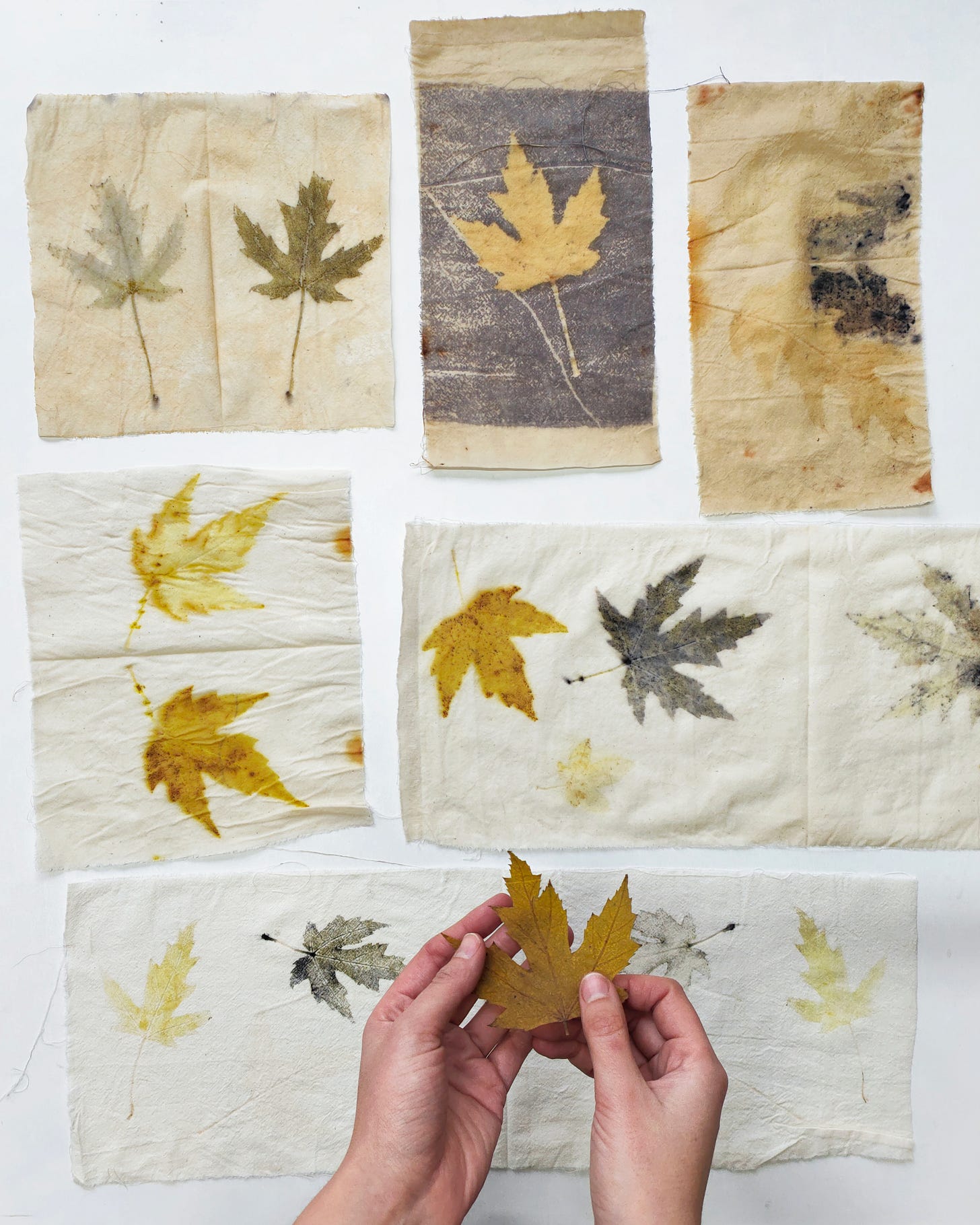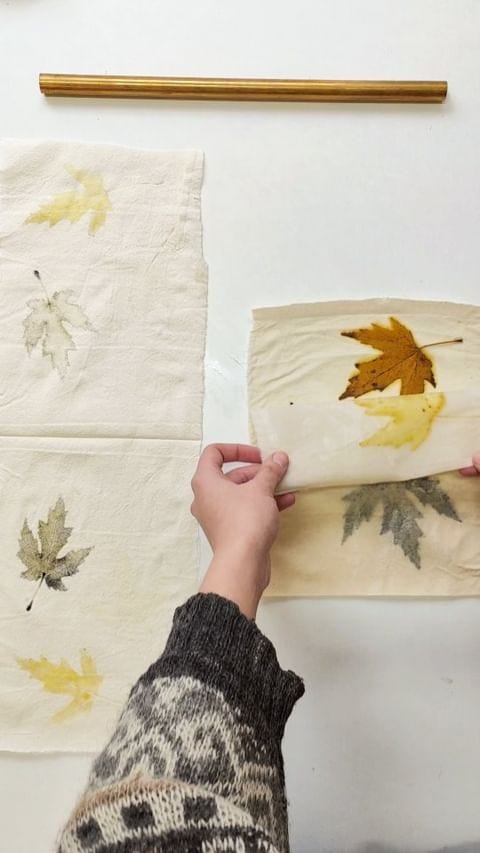Kaliko Journal is a free newsletter about natural dyeing, textiles, art practice, and life by Ania Grzeszek. This publication is divided into two sections: ”Plant Dyeing” and “Studio Practice”. You can manage your subscription by opting IN and OUT of the sections that interest you (click “Unsubscribe” at the bottom of the email).
Feel free to share parts of this letter wherever and with whomever you’d like. If you want to support my work, subscribe to this publication and/or purchase my handmade products. Take care of yourself wherever you are.
Do you ever feel like you want to make something but the ideas are not there? Everything you can think of is images you’ve already seen on Pinterest/Instagram/you-name-it. Nothing feels exciting or original.
I have a remedy for that. When I feel like my well of creativity is empty, I don’t overthink it. I simply choose a process that I find interesting and start sampling, without anything particular in mind. For example, last week I run some eco-print tests and
I can share the results with you in my weekly plant dyeing column and hopefully inspire you
I have 5 new ideas on how to incorporate eco-printing into my own work
Eco-printing is a process of pressing the entire dye plant against the fabric and transferring the color while the plant stays flat. The difference between bundle dyeing and eco print is that in bundle dyeing you use pieces of the plant scattered over the cloth, while in eco print the entire image is transferred. When you bundle dye, there's no need to keep the image flat. In eco-printing, this is crucial, as it allows the plant to touch the fabric with the whole surface.
For that reason, in eco-printing, you always need a rod to roll your cloth around, so that the rod can support an even plant-to-fabric transfer.
The process goes like that:
lay a (mordanted!) piece of cloth flat,
arrange the plants on top of the cloth,
(optionally: lay a piece of plastic barrier on top of the plants),
roll the entire package very carefully and tightly around a wooden/metal/plastic rod/can/pipe,
secure with a piece of string or a strip of fabric
and, finally, steam.
There are many variations you can incorporate into the process, like:
choosing a mordant to start with; using a barrier, or letting the image soak through the layers; which side up you arrange your leaves; soaking or drying the leaves before printing; working with a wetted or dry fabric; using an (iron) blanket to produce a negative image; to name a few!
My sampling is by no means extensive but it was enough to get my creativity going, and, hopefully, to inspire you to run your own tests, too.
The base for all my samples was a piece of aluminum mordanted cotton (mordanting recipe in my eBook about mordants) and mostly maple leaves I collected in my local park in Berlin, Germany. I worked with a plastic barrier on top of all the samples.
My sampling variations were:
aluminum-mordanted cloth vs aluminum+tannins vs aluminum+iron (all damp)
wetted aluminum-mordanted fabric vs dried aluminum-mordanted fabric
aluminum+tannins vs aluminum+tannins with an iron blanket on top
pressed leaves vs pressed leaves soaked in tap water for 10 days vs pressed leaves soaked in iron water for 10 days
Here are the results!
Learnings:
soaking leaves in water helps to achieve clearer prints and reduce the halo effect (note that the small soaked leaf is not a maple leaf hence the print is paler, yet still clearer)
soaking leaves in iron water before printing on aluminum is a great way of producing very dark prints while keeping the background white
eco-printing on aluminum+iron results in a less contrasting print: a beautiful muted green with a rusty background
all leaves print consistently better on the veins side (downside)
adding tannins to the background muted the result (note: I didn’t print any maple leaves here)
starting with a dry cloth and soaked leaves makes for the most striking, clearest prints, while a soaked cloth with dry leaves produces a watercolor-like image
dry-on-dry has no chance of transferring the dyes when working with a plastic barrier, which I wanted to illustrate here; at least one of the elements needs to be wet OR try sampling without plastic and see what happens
the iron blanket is simply a piece of cloth dipped in iron water and laid on top of the arrangement; the leaf works as a dye resist, while iron reacts with tannins
I got some second-hand T-shirts last week which I’m planning on decorating with leaves. I usually collect leaves in autumn and press them between pages of big books to use later in the year. Fresh spring leaves don’t have the same dyeing potential, so it’s important to stock up. It is possible to still find leaves in winter, at least where I live, so don’t worry you’d have to wait another 10 months. Also, I never pick leaves directly from the tree (idk, doesn’t feel right), but rather collect what is laying on the ground. Maple leaves are my favorite to work with because of the beautiful intricate shapes and wonderful dyeing potential, but I would encourage you to test other species, too. You can also eco-print with flowers, the process is the same, and, just like any dyeing technique, it’s best to start by sampling to get a proper hang of it!
And, before I go, here’s the video of the process:
I would be curious to know if you tried eco-printing in the past and if so—did you learn anything you’d like to share with us?
Take good care of yourself,
Ania
LINKS
Website - products and workshops
eBooks - purchase via Etsy
Instagram













I’ve recently rediscovered the joy of doing color tests (which should not be a revelation, but I guess after doing production for awhile I kind of forgot the importance of it) and these tests are so inspiring! It’s giving me lots of ideas for when fall comes
I have read out many articles related to eco-printing. But yours is the most detailed and practical tutorial for the thing. Thank you so much and go ahead ania!